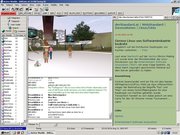Virtual world
|
|
A virtual world is a computer-simulated environment intended for its users to inhabit and interact with via avatars. This habitation usually is represented in the form of two or three-dimensional graphical representations of humanoids (or other graphical or text-based avatars). Some, but not all, virtual worlds allow for multiple users.
| Contents |
Overview
The world being simulated typically appears similar to the real world, with real world rules such as gravity, topography, locomotion, real-time actions, and communication. Communication has been in the form of text in current examples of an online world. This type of virtual world is now most common in massively multiplayer online games (Second Life, The Sims Online, There), particularly massively multiplayer online role-playing games such as EverQuest, Star Wars Galaxies, Ultima Online or Lineage. The first large scale virtual world was WebWorld, which later evolved into Active Worlds.
One perception of virtual worlds requires an online persistent world, active and available 24 hours a day and seven days a week, to qualify as a true virtual world. Although this is possible with smaller virtual worlds, especially those that are not actually online, no massively multiplayer game runs all day, every day. All the online games listed above include downtime for maintenance that is not included as time passing in the virtual world. While the interaction with other participants is done in real-time, time consistency is not always maintained in online virtual worlds. For example, EverQuest time passes faster than real-time despite using the same calendar and time units to present game time.
Single-player games
Many single player games also exist in a virtual world where the same rules and perception of a graphical reality exist. Many of these allow you to save the current state of this world instance to allow stopping and restarting the virtual world at a later date. (This can be done with some multiplayer environments as well.)
The virtual worlds found in video games are often split into discrete levels.
In The Classroom
Some teachers and university professors have adopted virtual worlds for educational purposes. Educators create an online community that students can log into and interact in. Within these educational virtual worlds, students will use their avatar to learn about new assignments and to create projects that are viewable within the virtual world. For example, students taking a computer manufacturing class can log into a virtual world in which they are the inhabitants of a burgeoning village that needs their expertise for the construction of houses, furniture, machines, and other goods.
History
The earliest virtual worlds were not games. The first virtual worlds presented on the Internet were communities and chat rooms, some of which evolved into MUDs and MUSHes. They attempted to create sets of avatars for virtual interaction. Community virtual worlds allowed access to the environment and encouraged creating buildings, art, and structures (and many did not include avatars).
One of the early prototyptes was WorldsAway, a prototype interactive community featuring a virtual world by CompuServe called Dreamscape and avatars representing the participants.
External link
- Virtual Worlds Review (http://www.virtualworldsreview.com/) - Introductory information on specific virtual worlds and virtual worlds in general.
- Terra Nova - virtual worlds blog (http://terranova.blogs.com/)

